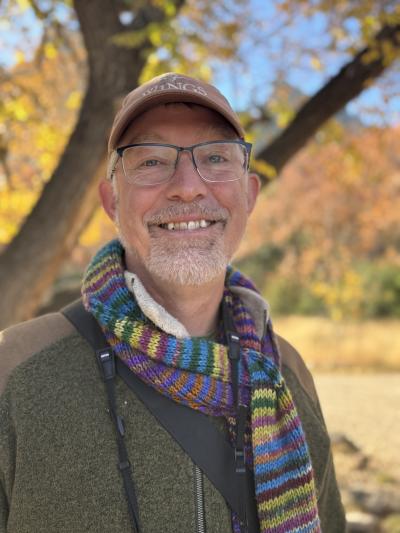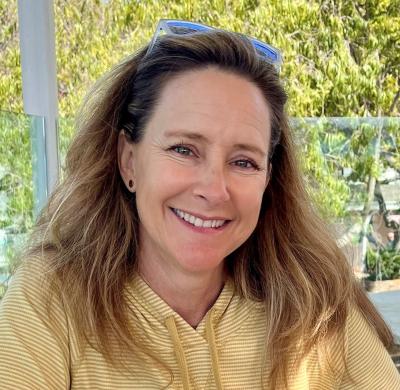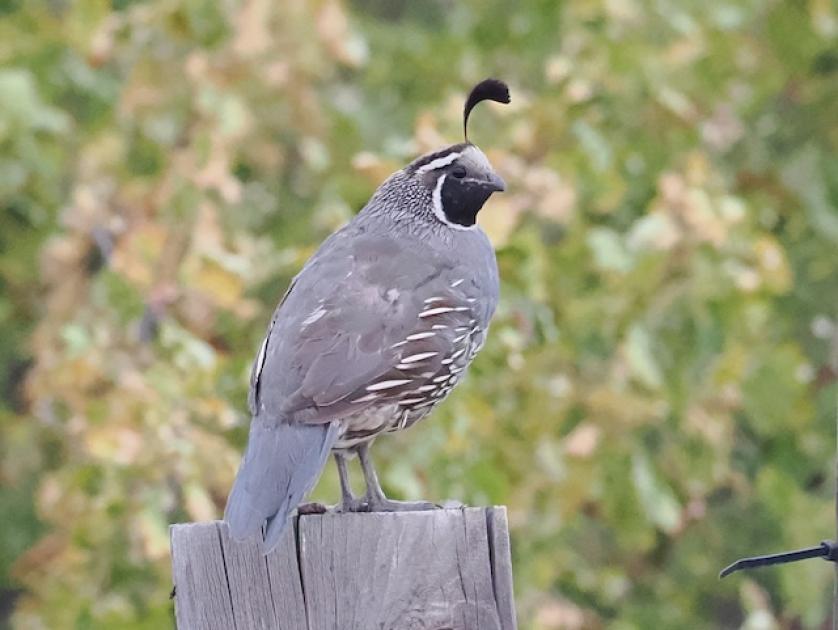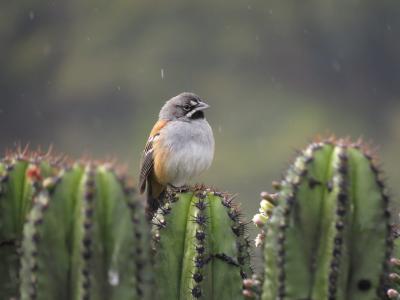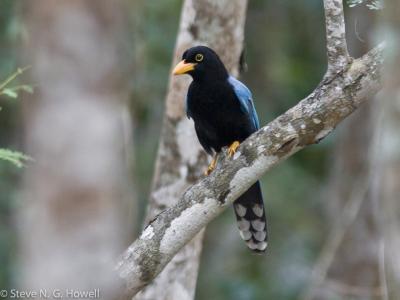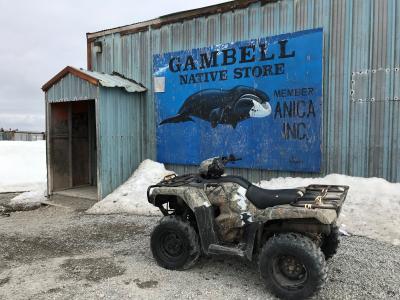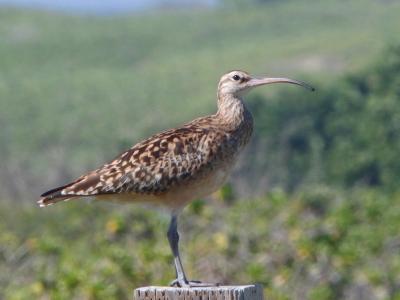Oregon in Late Summer
with Pelagic Extension
-
Aug 19-30, 2028
Rich Hoyer
Pelagic Extension to Sep 1
Tour Price to be Determined
Tour Price to be Determined
Oregon is well known for lush ancient forests and a picturesque coastline that teems with waterbirds. This is the Oregon west of the Cascade Mountains, where most of the human population resides. Less well known are the radically different habitats and climates as one moves south and east. In the “rain shadow” of the Cascades one finds dry open conifer forests, desert-like shrub-steppe, and stark vistas of canyons and fault-block mountains, while farther south one experiences warm summers with virtually no rain. It’s this meeting of Pacific, Continental, and Mediterranean climates in astonishing proximity that gives the state of Oregon an avian diversity greater than any other area in the world at a similar latitude—especially in woodpeckers and owls. We’ll explore most of this diversity in scenic state parks on the coast, vibrant national wildlife refuges in the Willamette Valley, extensive coniferous forests on both sides of the Cascades, and open expanses of sagebrush in the eastern deserts.
(This tour can be taken in conjuction with Oregon: Birds & Theater in 2025)
Main Tour
Main Tour
Day 1: The main trip begins at 6 p.m. in Portland. Night in Portland.
Excellent birding opportunities and great leadership from Rich Hoyer. He knows the birds, where and how to find them and how to get us on them. Rich also shared is knowledge and enthusiasm for other wildlife - butterflies, other insects, mammals and snakes (we had a great experience with a gopher snake), and as well how the forest and desert environments work and the geology of Oregon. I learned a lot! Our breakfast and lunch picnics were excellent, with healthy choices and enough variety. Rich made us a chocolate mousse treat one day!The pelagic day was outstanding! The boat and crew did a great job getting us out to the birds and back safely. Bird spotters, including Rich, helpied us identify and learn about the birds. We had amazing numbers of some species and a surprise Great Shearwater, which was on the wrong ocean! -Dixie S.
Day 2: We’ll begin the tour heading south from Portland up the Willamette Valley, a major trough for the river of the same name that flows north between the Coast Range and the Cascades. Although it is the most agriculturally productive region in the state (with such diverse crops as wine grapes, irises, berries, filberts, grass seed, and Christmas trees), large stretches of riverine forest are well protected, and five national wildlife refuges are well-birded hotspots. California Scrub-Jay, Black-headed Grosbeak, Violet-green Swallow, and Vaux’s Swift are examples of common breeding species, and the improved wetlands at the refuges have recently hosted such surprises as Black-necked Stilt, and breeding Wilson’s Phalarope and Black Tern. The large cottonwoods and riparian thickets along the Willamette River and its tributaries are home to Pileated Woodpecker, Willow Flycatcher, and the sometimes spotless oregonus race of Spotted Towhee. Night in Corvallis.
Day 3: Early this morning we’ll drive to the meadow-capped top of Marys Peak, at 4,097 feet the highest point in the Coast Range, where one can often see and sometimes even hear the Pacific Ocean 27 miles away. Northern Pygmy-Owl, Canada Jay, Red-breasted Sapsucker, and Varied Thrush are some of the forest birds we might see, but our main targets are the elusive Sooty Grouse and Mountain Quail. Both are actually common here though hard to see; late summer is the best time to look for them. Later in the day we’ll visit valley refuges and the requisite sewage ponds for migrant water birds. An evening outing to a nearby forest should yield Western Screech-Owl and possibly also Barred Owl. Night in Corvallis.
Days 4-5: Shorebird migration will be in full swing, so we’ll head a bit south and west to Florence and spend the next two days on the stunningly beautiful and rightfully famous Oregon Coast. From towering headlands and rocky shores we’ll spot Western Gull, Brandt’s and Pelagic Cormorants, and Surf Scoters while keeping an eye out for the scarce Black Oystercatcher, Black Turnstone, Surfbird, and Wandering Tattler. Amongst the scoters we may spot Rhinoceros Auklet, Marbled Murrelet, and Red-necked Grebe. We’ll check estuaries and mudflats for concentrations of migrant shorebirds which could include Western, Least, Baird’s, and Pectoral Sandpipers, loons, and Heermann’s Gulls. Nights in Florence.
Day 6: Today we head east over the Cascade Mountains. Following the Willamette River into the western foothills of the Cascade Mountains, we’ll stop to admire the lovely, rushing mountain streams while eyeing the boulders for American Dippers. A short stroll through a grove of ancient Pacific Silver Fir, Douglas-fir, and Western Hemlock could reveal mixed flocks including Brown Creeper and Golden-crowned Kinglet. As we climb the higher mountains and cross the divide, the habitat changes abruptly and dramatically, from a dripping, dense fir-hemlock rainforest to Lodgepole Pine on lava flows only a few thousand years old, to a dry, open Ponderosa Pine–Western Juniper woodland punctuated by willow- and aspen-lined streams. In these drier east-side forests we could see Red-naped Sapsucker, Pygmy Nuthatch, and Green-tailed Towhee. Five species of chipmunk are possible (though telling them apart is a challenge), and if it’s warm enough we could see some delightful butterflies, such as Golden Hairstreak and Lorquin’s Admiral, and bright blue-tailed Western Skinks are common here. Night in Christmas Valley.
Day 7: The primary birding area for this morning is the landlocked basin of Summer Lake, where numbers of gulls, avocets, stilts, and phalaropes breed and stage on their migrations. Some years the numbers of birds are staggeringly high, and we hope to witness such an unparalleled spectacle. Migrant shorebirds are also in evidence here, and we’ll especially be on the lookout for the locally breeding Snowy Plover. After a picnic lunch in the nearby hills we’ll drive past the impressive Abert Lake basin located below the rim of the same name on our way to the next hotel. Night in Burns.
Days 8-10: We’ll have three full days to explore the watersheds of the Harney Basin. Malheur National Wildlife Refuge, which encompasses the heart of this landlocked basin as well as the Donner und Blitzen River valley to the south, is located only 30 miles south of Burns. Well before we actually arrive at the refuge we’ll be birding along the route south of town. Water levels can vary greatly from year to year, but with luck roadside stops will feature ponds and lakes with many species of ducks, Clark’s and Western Grebes, and Wilson’s Phalaropes. Swainson’s Hawks will be thinking about their southward migration, while arctic-breeding Gambel’s White-crowned Sparrows may already be arriving. We’ll check the wildlife refuge headquarters, an oasis of spruce, pine, cottonwood, and elm, as well as other groves of trees such as Benson Pond and P Ranch. These isolated groves in a sea of sagebrush act as migrant traps in spring and fall, and there’s usually a family group of Great Horned Owls roosting in the trees at one of them. We’ll also check the dry upland habitats for sage and juniper specialties such as Sage Thrasher and Sagebrush Sparrow, and we can always hope for a wandering Greater Sage-Grouse on the roadside as we also keep an eye on the cliffs and rimrock for White-throated Swift and Chukar. One of the tour highlights will be our drive to the top of wonderfully scenic Steens Mountain, a fault block mountain with Oregon’s highest road at 9,500 feet, not passable before about July 4 each year due to snow. The view of the Alvord Basin, Oregon’s driest desert, stretching 5,600 abrupt feet below, is awesome. We even have a chance of seeing Black Rosy-Finch in its only known breeding location in the state, as well as an isolated introduced population of Bighorn Sheep.
On the day between trips south to the refuge we’ll venture north into the Silvies River drainage in the superb pine-fir-larch woods of the Ochoco and Blue Mountains. Here we have an excellent chance of finding Williamson’s Sapsucker, White-headed Woodpecker, Clark’s Nutcracker, and Red Crossbill, among many other species. We’ll also make an evening visit here to look for Flammulated Owl, which though difficult to see well can be surprisingly common. Nights in Burns.
Day 11: Our drive back to Portland will take us west and north along the scenic John Day River, the second-longest free-flowing river in the lower 48 states. Stops along the way may reveal breeding birds of the coniferous forests such as Lewis’s Woodpecker and Townsend’s Warbler, and we’ll include a visit to the John Day Fossil Beds National Monument visitor center. Once we reach the freeway east of The Dalles, we’ll head downriver through the rightfully famous Columbia River Gorge National Scenic Area, where the continent’s second-largest river cuts right through the Cascade Mountains, and waterfalls and windsurfing opportunities attract many tourists. We’ll have our farewell dinner at the historic Multnomah Falls Lodge in view of the tallest falls in the state before continuing to Portland. Night in Portland.
Day 12: The main trip concludes this morning in Portland.
Newport Post-Tour Pelagic
Day 1 (12): The post-trip extension begins as we leave from our hotel in Portland in the morning and start the three-hour drive to Newport, birding along the way. Once at the coast we’ll have dinner, stock up on lunch and snacks for the boat trip and check into our hotel. Night in Newport.
Day 13: We’ll get to the Newport harbor early in the morning for our all-day boat trip, which departs around 7:00 a.m. As soon as we leave the jetties of the Yaquina River behind, we could start seeing nearshore species such as Common Murre and Pigeon Guillemot, and we’ll make a special effort to look for Marbled Murrelet as well as mammals such as Gray Whale. We’ll then motor for a couple more hours to the edge of the continental shelf, stopping whenever we see birds, such as the likely Sooty and Pink-footed Shearwaters. At the farthest point we should see Black-footed Albatross, migrant jaegers (all three species are possible), Arctic Tern, and both Red and Red-necked Phalaropes. We’ll be back in port by about 3:00 p.m., finishing the day with our drive back to Portland. Night in Portland.
Day 14: The tour concludes this morning at the Portland Airport area hotel.
Note: The information presented here is an abbreviated version of our formal General Information for this tour. Its purpose is solely to give readers a sense of what might be involved if they take this tour. Although we do our best to make sure that what follows here is completely accurate, it should not be used as a replacement for the formal document which will be sent to all tour registrants, and whose contents supersedes any information contained here.
ENTERING THE UNITED STATES: Non-U.S. citizens will need a valid passport and may need a tourist visa. Consult your nearest U.S. Embassy or consulate for details.
PACE OF THE TOUR: Most mornings will start around 6:00 a.m. (a few will start earlier) and we bird most days through lunch until mid-afternoon. Every day we’ll schedule one to two hours off at the hotel before dinner, some days even a bit more, and on a couple long days we’ll head almost directly to dinner. On a few evenings we plan on optional owling after dinner (where having a small flashlight or headlamp will be necessary).
Our longest walks may be two miles round trip. One walk we may do depending on weather is a road that is almost continually up to the top at Marys Peak at 4100 feet elevation; it is less than ½ mile each way, and a nice road (though closed to public traffic), but a walking stick would be useful. Most walking is done on roads and trails, although there will be some over uneven ground and possibly in marshy/dewy grass. Some days, especially travel days, we do more birding stops just outside the van. Sturdy footgear, waterproof if possible, is important, and a hiking stick is recommended for anyone with balance problems or weak knees. One should be prepared for long periods of standing and walking slowly, and a small travel stool is handy for those who find this tiring.
Bathroom Breaks: Breaks for restroom use will be made throughout the tour.
HEALTH: Oregon presents no real hazards to the visiting birdwatcher but certain factors must be considered.
Elevation: Some of our birding is at elevations of around 7000 feet (one day up to 9000 feet), and while we do not schedule anything even faintly strenuous at these altitudes, anyone with a history of cardiovascular or respiratory problems should be aware of the altitudinal stress. Please consult your physician.
Sun: High-altitude sun can be intense; a broad-brimmed hat, proper clothing and a strong sun block lotion are essential.
Smoking: Smoking is prohibited in the vehicles or when the group is gathered for meals, checklists, etc. If you are sharing a room with a nonsmoker, please do not smoke in the room. If you smoke in the field, do so well away and downwind from the group. If any location where the group is gathered has a stricter policy than the WINGS policy, that stricter policy will prevail.
Sea Sickness: Those participating in the pre-tour pelagic should be prepared at a minimum for big swells.
Miscellaneous: We actively look for reptiles but rattlesnakes are seldom seen. Insects are rarely bothersome, though mosquitoes may be locally numerous towards the end of the tour, varying from year to year. We recommend sturdy boots of at least ankle height as a safeguard against twisted ankles when walking over uneven terrain. A walking stick is recommended for anyone with balance problems or weak knees. Finally, participants should bring an adequate supply of any personal medications as they may be difficult to obtain during the tour.
CLIMATE: Oregon in summer has a beautiful, moderate and dry climate, but weather can vary greatly. Since we’ll be ranging from sea level on the humid coast to more than 7000 feet in the very dry rain shadow of the Cascades, expect a wide range in temperatures. Though rain is unlikely, one should be prepared for the unexpected. It could be cool, foggy and breezy on the outer coast, hot in the inland valleys, and with cool nights east of the mountains: we may experience temperatures ranging from 32° to 100° F on the tour, with averages ranging 50° to 80°F.
Our Pelagic: For the pelagic trip, even on a warm, sunny day, the air moving across the cold Pacific Ocean can be surprisingly brisk. Given the chance for spray, one should be prepared with waterproof shoes (rubber boots with good traction are ideal) as well as hat (one that won’t blow away), gloves, and wind/waterproof rain jacket and pants.
ACCOMMODATIONS: We’ll be staying at standard, comfortable motels and/or lodges throughout the tour. Two of our hotels have indoor swimming pools; all have wireless internet.
FOOD: Food will be North American standard with a chance of good seafood along the coast,
Food Allergies / Requirements: We cannot guarantee that all food allergies can be accommodated at every destination. Participants with significant food allergies or special dietary requirements should bring appropriate foods with them for those times when their needs cannot be met. Announced meal times are always approximate depending on how the day unfolds. Participants who need to eat according to a fixed schedule should bring supplemental food. Please contact the WINGS office if you have any questions.
TRANSPORTATION: With the exception of our pelagic trip (see below) we will be traveling by 12 or 15 passenger window van or minivan, depending on the group size. Participants should be able to ride in any seat in tour vehicles.
Our pelagic boat (on the pre-tour extension) will be either 50 or 55 feet long, with a capacity of at least 30 passengers; our group will be a minority among those aboard as the trip is open to the public. There will be at least one toilet, and we’ll bring our own food and drink.
2025 Narrative
Brief Summary
Our Oregon in Late Summer WINGS tour in late August and early September went extraordinarily well, with little to no forest fire smoke, superb weather, a great group of participants, and a fabulous roster of bird sightings during our twelve days in the field. Favorites from the coast included a flock of adorable Bushtits at super close range, great views (and photos) of Rhinoceros Auklet between the jetties of the Siuslaw River, and a juvenile Northern Saw-whet Owl that we managed to see perched in the open. Unforgettable was the magical fogbow that appeared when the sun began burning off the low beach fog, and Snowy Plovers pattered in the sand ahead of us. Finley National Wildlife Refuge's confiding Wrentits were delightful, while in the highest part of the Coast Range alongside stunning vistas from Marys Peak were a trio of Mountain Quail, first spotted skulking in the thicket of a fallen fir tree before flying over alpine meadow. East of the Cascades we first found White-headed Woodpecker and Pygmy Nuthatch in their classic Ponderosa Pine habitat, while were met with an amazing barrage of water birds at Summer Lake State Wildlife Area: several American Bitterns perched visibly, and Eared Grebes swam with impossibly cute babies riding on the parent's back, while a family group of Great Horned Owls were in the old barn there. The Malheur National Wildlife Refuge and the whole Harney Basin was a gorgeous place to finish up the tour, where we picked up several migrants and saw flock of the scarce Black Rosy-Finch at the top of Steens Mountain. An unplanned detour through the residential area of Burns on our last morning illustrated how that area's Christmas Bird Count manages to tally the largest number of California Quail in the country – several coveys numbering hundreds of birds scampered and fed in the streets and yards everywhere we looked. The pelagic trip extension was simply amazing – calm seas and little wind, lots of Black-footed Albatrosses, a few Laysan Albatrosses, and large flocks of Fork-tailed Storm-Petrels were just some of the highlights. In addition to the birds, we enjoyed our picnic breakfasts and lunches in lovely settings and saw some great mammals such as Raccoon, American Badger, and Bighorn Sheep.
Detailed Summary
We started the bird list already on Day 1 with a quick stop before dinner at Broughton Beach, where several Ospreys were the main attraction, but birding began in earnest the next morning at Tualatin River National Wildlife Refuge, where we were met by WINGS founder Will Russell. Shorebird diversity was nice here, but the swallows stole the show, a clean sweep of all seven Oregon species including a rare Bank Swallow. We would later see Violet-green Swallow well at the Monmouth Sewage Ponds before our first picnic lunch at Helmick State Park. At Helmick we called in a mob that gave us great views of Chestnut-backed Chickadee, Red-breasted Nuthatch, and our only Hutton's Vireo of the tour. We later stopped at a park where in short order we were watching our target Acorn Woodpeckers.
It's unusual to get all three targets on our morning to gorgeous Mary's Peak, but we did it the next morning. We had to drive the last couple of miles twice, but on the way back up, our target Sooty Grouse was in the road. At the top parking lot, a Northern Pygmy-Owl tooted for a while then perched quietly for a long time, presumably hoping to be forgotten by the mob of Red-breasted Nuthatches so it could get breakfast. We later had Mountain Quail lower down, seen well by just a few but in flight by all. Golden-crowned Kinglet was another highlight from the top of Marys Peak before we retreated to Alsea Falls for picnic lunch. There we had both American Dipper and California Sister in the shallows above the falls. We worked hard for Western Screech-Owl on an after-dinner trip, hearing two of them well, but neither being interested enough to come close.
Our third day began at Finley National Wildlife Refuge with migrant Swainson's Thrushes calling from the undergrowth and a pair of Wrentits coming in very close. Cabell Marsh nearby had good numbers of American White Pelicans. We paid a second visit to Philomath Sewage Ponds, spotting two migrant Red-necked Phalaropes that hadn't been there the day before. Once at the coast we stopped by some rocks on the beach that had our first Black Oystercatcher and many Brown Pelicans. The highlight at our lunch stop at Ona Beach were the Heermann's Gulls, the best views we would get of this species. At Yachats we did some fun ocean watching where Marbled Murrelets were bobbing in the waves, while a Wandering Tattler wandered on the rocks below and a Brown-headed Cowbird showed well back towards town.
Our full day on the Lane County coast near Florence was, well, full. A highlight from our picnic breakfat spot was a very close Pacific Wren and lone Band-tailed Pigeon that sat for scope views. At nearby Siltcoos Beach we felt our way through the fog until it began to burn off, revealing a stunning fogbow and two Snowy Plovers at our feet. Once the ocean was visible, we watched from the top of the dune, seeing very close Pink-footed Shearwaters and Pacific Loons before they realized how close they were to land and moved offshore. Between the jetties of the Siuslaw River were father-chick pairs of Common Murres, several Pigeon Guillemots, and three Rhinoceros Auklets. We picnicked at the fascinating California Pitcher Plant wayside, then dipped a bit into Lincoln County for the spectacular views from Cape Perpetua. Those who forewent some sleep after dinner were treated to an American Barn-Owl flying over, followed by a cooperative juvenile Northern Saw-whet Owl, and a distant pair of calling Barred Owls.
As we headed back inland, we stopped for breakfast in the middle of the Coast Range where Red-breasted Sapsucker was the target. It took some work but we eventually had great views of a pair. A Brown Creeper was the highlight at Fern Ridge Reservoir, and the garden of Calliope Corner had several feisty Rufous Hummingbirds, making the normally abundant Anna's Hummingbirds a challenge to see well. The lunch highlight was the view of spectacular Salt Creek Falls, while nearby failed attempts to find Three-toed Woodpeckers resulted in a good sighting of the little-known Shadow Chipmunk as well as two family groups of Canada Jays. As soon as we made a stop in a grove of old Ponderosa Pines, we heard a group of Pinyon Jays just as they were moving off out of sight. But we were able to find two of our targets here, White-headed Woodpecker and Pygmy Nuthatch. After viewing Fort Rock for its fascinating geology, we marveled at the number of Red-tailed Hawks along the roads, finally getting great views of a Ferruginous Hawk in one of the fields. The small marsh next to the restaurant where we had dinner in Christmas Valley was full of birds, including our first Ruddy Ducks.
Summer Lake State Wildlife Area did not disappoint this year, as it was nonstop birding from breakfast to lunch. Marsh Wrens were so numerous to be impossible to census accurately, and we could only estimate the numbers of the dozen species of ducks there. Memorable sightings included several American Bitterns, a family of Virginia Rails foraging in the open, many Black-necked Stilts, and a family of Eared Grebes, with the babies riding on the parents' back. Lunch up in the pine forest was much quieter, but we still were impressed by a White-headed Woodpecker and our first Mountain Chickadees. The numbers of birds that graced the shallows of Lake Abert was hard to comprehend, so we just enjoyed the spectacle while also stopping for a great view of a Bighorn Sheep just above the road.
The wind forecast prompted us to visit Steens Mountain on our first day in the Malheur area, normally saved for last day as a grand finale for its spectacular views. We started with a family of Golden Eagles on the slopes above the highway, delaying our picnic breakfast in Frenchglen, where highlights were Black-chinned Hummingbird and MacGillivray's Warbler. The views up at Kiger Gorge and East Rim did not disappoint, and we were lucky to have a nearly windless and smoke-free day on top of the mountain, though we did have to dodge unusual rain showers. We lucked into a flock of Black Rosy-Finches which didn't linger long for the best of views. Spectacular though were the close fly-bys of several White-throated Swifts right at the peak. We made a stop before lunch to look for migrants along the Blitzen River, getting great views of a Canyon Wren as well as a surprise vagrant Red-eyed Vireo.
Our second day based out of Burns found us in the fabulously diverse coniferous forests of the Blue Mountains. At Idlewild Campground were loose groups of Red Crossbills of at least two types, including the rather out-of-place Type 3 (Hemlock). A MacGillivray's Warbler female showed unusually well here. We made a stop at the Swick Old Growth grove where we had very cooperative Pygmy Nuthatches, and a lone fly-by Clark's Nutcracker perched just right for us, the only one of the entire tour. We then made a beeline for Aldrich Mountain for the stunning views, seeing many migrant Lewis's Woodpeckers and a Prairie Falcon on the way. After lunch we birded the lovely mixed conifer forest, finding a stunning male Williamson's Sapsucker and the very local Slate-colored Fox Sparrow.
Our full day at Malheur National Wildlife Refuge began with Wilson's Snipes in a mudflat close to the road but only obvious if you knew exactly where to look. There were plenty of migrants to look at during our walk around the headquarters oasis, including several Black-chinned Hummingbirds briefly joined by a single Calliope Hummingbird, an Olive-sided Flycatcher, and a Brewer's Sparrow that unseasonably broke out in song at one point. A small group of female or juvenile Bobolinks was a very lucky find along the Center Patrol Road nearby. The oasis at Benson Pond had a Cassin's Vireo, Townsend's Solitaire, Great Horned Owl, and an American Barn-Owl. We picnic lunch at Page Springs where we heard a skulking Yellow-breasted Chat and had migrant Cedar Waxwings and a Lewis's Woodpecker. We made stops of interest at Diamond Craters and the Pete French Round Barn, pausing on the way back to Burns for a huge flock of Yellow-headed Blackbirds in a field.
An impromptu visit to the local post office as we were departing Burns took us through residential neighborhoods where we got a taste of the abundance of California Quail in town, with many multiple-family coveys around every corner. Mountain Bluebirds graced our picnic breakfast spot in the Silvies Ranch valley, with Sandhill Cranes nearby just down the road. We made a stop at an old burn to arrive at a bunch of bird activity. Again, two types of Red Crossbills were in the treetops, as was a Cassin's Vireo and our second Williamson's Sapsucker. Just down the road we stopped to rescue a Valley Garter Snake that was crossing the highway, only the second snake of the tour. A quick check for migrants during our short Clyde Holliday Park stop resulted in a vocal Western Screech-Owl whose roost up in a cottonwood we readily found. The long drive back to Portland was broken up with worthwhile stops at the John Day Fossil Beds National Monument, including lunch at the Painted Hills, and we ended the day with our farewell dinner in sight of the lovely Multnomah Falls.
- Richard Hoyer, 2025
Rich knows Oregon and its birds and had a great plan to maximize our birding experience.
- John D. on Oregon in Late Summer
Excellent birding opportunities and great leadership from Rich Hoyer. He knows the birds, where and how to find them and how to get us on them. Rich also shared is knowledge and enthusiasm for other wildlife - butterflies, other insects, mammals and snakes (we had a great experience with a gopher snake), and as well how the forest and desert environments work and the geology of Oregon. I learned a lot! Our breakfast and lunch picnics were excellent, with healthy choices and enough variety. Rich made us a chocolate mousse treat one day! The pelagic day was outstanding! The boat and crew did a great job getting us out to the birds and back safely. Bird spotters, including Rich, helped us identify and learn about the birds. We had amazing numbers of some species and a surprise Great Shearwater, which was on the wrong ocean!
- Dixie S. on Oregon in Late Summer
Rich is an outstanding leader. Starting at the orientation meeting he clearly explained what was expected of us with respect to behavior on the trails, in the van, and he set up a WhatsApp group to facilitate communication with the group. He is extremely knowledgeable about the birds and their respective songs and calls. He is personable, outgoing, enthusiastic and patient. He works hard to ensure that everyone would see the birds that were being spotted. Our picnics, breakfasts and lunches both, were outstanding. Rich went out of his way to make them so. It is amply clear that he loves what he does.
- Marisa W. on Oregon in Late Summer
This tour is limited to seven participants with one leader.


































